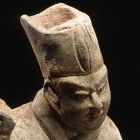J.J. Lally & Co., Oriental Art / New York City, New York
MenuPast Exhibition
Ancient Chinese Sculpture: Recent Acquisitions
March 14 - April 5, 2014
11.
A PAIR OF GRAY POTTERY SCHOLAR-OFFICIALS
Song Dynasty (A.D. 960-1279)
shown standing with heads turned as if engaged in serious debate, their faces expressively modelled and well detailed, one with eyes set in a concentrated, thoughtful gaze, wearing a simple robe with close-fitting sleeves and a knotted cloth belt, with his right arm raised as if to emphasize an important statement, the hand lost in antiquity, his headdress gathered to a crease at the front and rising up to a high rim at the back, the other with furrowed brow and a finely incised moustache, shown wearing more elaborate layered robes with deep sleeves and a court belt applied with square plaques visible across his back, his headdress of plain high domed form, standing quietly with his hands folded at his waist, each figure resting on a plain flat circular base with the toes of the shoes emerging beneath the hem of the robes, the hard gray pottery showing rust-red earth lightly encrusted on the surface, particularly on the back, the style and materials characteristic of Sichuan province.
Height each 11 1⁄2 inches (29.2 cm)
Provenance
American Private Collection
J. J. Lally & Co., Ancient Chinese Tomb Sculpture, New York, 2004, no. 12
Song dynasty tomb sculpture is quite rare. Tombs and tomb furnishings in the Song dynasty were far less elaborate than in the typical Han or Tang burial, and the use of pottery tomb sculpture was abandoned or greatly curtailed throughout China during the Song dynasty.
Compare the similarly modelled partially glazed red pottery figures of scholar-officials discovered in the Eastern outskirts of Chengdu, Sichuan province in the Northern Song dynasty tomb of Zhang Que and his wife, with an epitaph dated to A.D. 1093, illustrated in Wenwu, 1990, No. 3, pl. 1, figs. 4-6, with line drawings on p. 4, fig. 4, nos. 1-4.
宋 灰陶文侍俑一對 高 29.2 厘米
